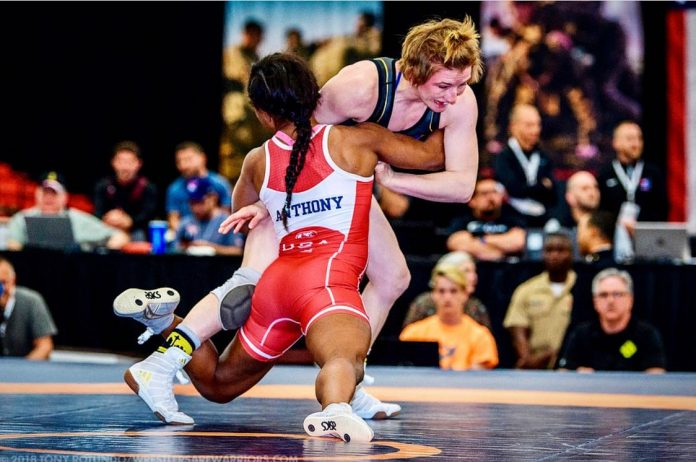
Takedowns are a painful subject for many folks in BJJ. It is not that we can’t learn them, or the old excuse that there are entire martial arts that revolve around takedowns and we can’t find a way to fit them all in our “busy” Jiu-Jitsu schedules. The truth is, we’re just lazy. Being lazy has its perks in Jiu-Jitsu, but not in the realm of takedowns. We can, however, be smart about them and figure out stuff that fits into BJJ standing exchanges rather than trying to learn high-percentage takedowns that work better in other grappling martial art. The inside trip takedown is the perfect example of a move tailor-made for BJJ.
The takedown game is usually perceived as a game of surprise, explosion, and speed. Instead, it is much simpler than that – it is a game of angles. You could certainly employ all of the above qualities in your game, but given that they’re more or less based on athleticism, they are not sustainable over a lifetime of training. Looking to exploit weaknesses by creating favorable angles and off-balancing people is a much better strategy over the long haul. The inside trip takedown will work for you in both cases, but it is much easier to set up and execute if you master the “lazier” aspects of it. It is the BJJ way after all, isn’t it?
The Inside Trip Takedown – Mechanics
Apart from the fact that it doesn’t require you to explode into penetration steps or crazy exchanges, the inside trip takedown has another specific quality that makes it perfect for BJJ and MMA. It works from the clinch, which is pretty much where we find ourselves in both Jiu-Jitsu and mixed martial arts. Unlike wrestling, the danger of strikes in MMA and the presence of the Gi in BJJ guarantee people engage in a clinch-like fashion. Setting up double legs from the position, or even certain Judo throws oftentimes proves to be extremely hard. The easy way out, or rather down, is via the inside trip takedown.
Let’s start by looking at the mechanics of the inside trip takedown by dividing it into upper and lower body mechanics. While I did mention a clinch it doesn’t necessarily have to be any specific clinch position. As long as people are connected at the upper body level, you can look for the inside trip takedown. A usual set up involves an over-under, which allows you to push/pull an opponent into any desired direction. It is the rotational control that allows you to pivot an opponent straight into the inside trip. On that note, the underhook side is the one that matters most.
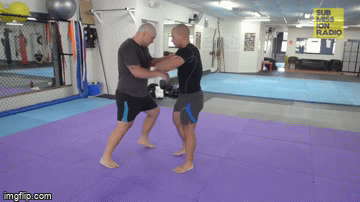
Finishing mechanics is easy. You have great balance because you’re in a bladed stance, while your opponent is more square. Entangling your front leg with the leg they step forward (at knee level, heel to the outside) is all you need to undermine their balance. And upper body push is all it takes to tumble anyone over to the floor.
Entry Options
The most important aspect of the inside trip takedown is not the mechanics. You can master those in a week, and keep them crisp with constant drills. It is the entry that will take more training than anything. That is where those angles I talked about earlier really come into play.
First and foremost, you have motion. Getting to the clinch in a way that allows you to be safe and set up the inside trip takedown involves is what determines its success most of the time. Two things make or break the motion when looking for an inside trip – a bladed stance, and the proper grip structure to give you the advantage. The over/under described above was just an example. In reality, you like to crate dominant angles by body locking, or going for an arm drag to set the inside trip takedown up.
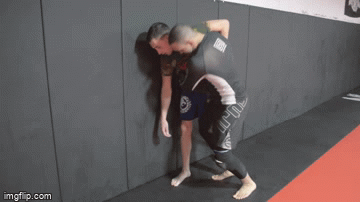
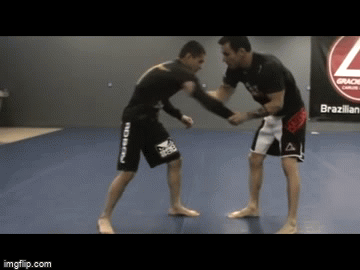
What Comes Next?
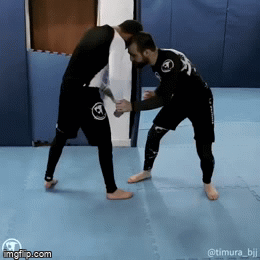
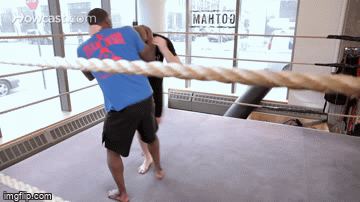
All In All
The inside trip takedown is an easy one to implement in your game. It works in Gi, in No-Gi, it is very useful in MMA and any other grappling situation you might find yourself in. Khabib Nurmagomedov, Alexander Volkanovski, Yoel Romero are just some of the fighters that have had immense success with it. Try and introduce it to your takedown game and use angles and tactics over speed and power to get people down to the mat.


![Darce Choke Encyclopedia – Origins, Mechanics and Variations [2025] BJJ, choke, Brabo, BJJ Darce Choke, D'arce Choke, Darce BJJ Choke](https://bjj-world.com/wp-content/uploads/2017/11/JungPoirierLeeYahoo-218x150.jpg)









![Get Off My Legs Gringo Craig Jones DVD Review [2025] Get Off My Legs Gringo Craig Jones DVD Review](https://bjj-world.com/wp-content/uploads/2025/03/get-off-my-legs-gringo-craig-jones-dvd-review-218x150.png)

![Leg Lock Entries Helena Crevar DVD Review [2025] Leg Lock Entries Helena Crevar DVD Review](https://bjj-world.com/wp-content/uploads/2025/03/leg-lock-entries-helena-crevar-dvd-review-218x150.png)
![Special K Guard Neil Melanson DVD Review [2025] Special K Guard Neil Melanson DVD Review](https://bjj-world.com/wp-content/uploads/2025/03/special-k-guard-neil-melanson-dvd-review-218x150.png)
![Arm Bar It All Shawn Melanson DVD Review [2025] Arm Bar It All Shawn Melanson DVD Review](https://bjj-world.com/wp-content/uploads/2025/03/arm-bar-it-all-shawn-melanson-dvd-review-218x150.png)



![Advanced Immortal Clinch Matt Brown DVD Review [2024] Advanced Immortal Clinch Matt Brown DVD Review](https://bjj-world.com/wp-content/uploads/2024/09/advanced-immortal-clinch-matt-brown-dvd-review-100x70.png)


![Miko Hytonen Lapel Chokes From Everywhere DVD Review [2024] Miko Hytonen Lapel Chokes From Everywhere DVD Review](https://bjj-world.com/wp-content/uploads/2024/10/miko-hytonen-lapel-chokes-from-everywhere-dvd-review-100x70.png)
![Shin to Shin Eoghan O’Flanagan DVD Review [2025] Shin to Shin Eoghan O'Flanagan DVD Review](https://bjj-world.com/wp-content/uploads/2024/12/shin-to-shin-eoghan-oflanagan-dvd-review-100x70.png)




![Compass Kneebar System Charles Harriott DVD Review [2024] Compass Kneebar System Charles Harriott DVD Review](https://bjj-world.com/wp-content/uploads/2024/11/compass-kneebar-system-charles-harriott-dvd-review-100x70.png)
![Knee Lever John Wayne Sweep Adam Wardzinski DVD Review [2024] Knee Lever John Wayne Sweep Adam Wardzinski DVD Review](https://bjj-world.com/wp-content/uploads/2024/12/john-wayne-sweep-adam-wardzinski-dvd-review-100x70.png)


![Closed Guard Reintroduced Adam Wardzinski DVD Review [2025] Closed Guard Reintroduced Adam Wardzinski DVD Review](https://bjj-world.com/wp-content/uploads/2025/01/closed-guard-reintroduced-adam-wardzinski-dvd-review-100x70.png)
![Special K Guard Neil Melanson DVD Review [2025] Special K Guard Neil Melanson DVD Review](https://bjj-world.com/wp-content/uploads/2025/03/special-k-guard-neil-melanson-dvd-review-100x70.png)

![Effectively Passing The Guard Luke Griffith DVD Review [2025] Effectively Passing The Guard Luke Griffith DVD Review](https://bjj-world.com/wp-content/uploads/2025/01/passing-the-guard-luke-griffith-dvd-review-100x70.png)



![Slip N Slide Into Victory Julián Espinosa DVD Review [2025] Slip N Slide Into Victory Julián Espinosa DVD Review](https://bjj-world.com/wp-content/uploads/2025/01/slip-n-slide-into-victory-julian-espinosa-dvd-review-100x70.png)


![Creating Back Exposure Luke Griffith DVD Review [2025] Creating Back Exposure Luke Griffith DVD Review](https://bjj-world.com/wp-content/uploads/2025/01/creating-back-exposure-luke-griffith-dvd-review-100x70.png)
![Dubious De La Riva Dominique Bell DVD Review [2024] Dubious De La Riva Dominique Bell DVD Review](https://bjj-world.com/wp-content/uploads/2024/10/dubious-de-la-riva-dominique-bell-dvd-review-100x70.png)

![Basic Closed Guard Jasmine Rocha DVD Review [2024] Basic Closed Guard Jasmine Rocha DVD Review](https://bjj-world.com/wp-content/uploads/2024/11/basic-closed-guard-jasmine-rocha-dvd-review-100x70.png)
![Daisy Fresh WHITE BELT Wrestling Curriculum DVD Review [2024] Daisy Fresh WHITE BELT Wrestling Curriculum DVD Review](https://bjj-world.com/wp-content/uploads/2024/10/daisy-fresh-white-belt-wrestling-curriculum-review-100x70.png)